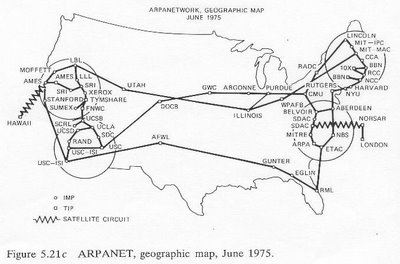 PHOTO: an ARPANET geographic map from June, 1975 is shown in the textbook by Leonard Kleinrock, "Queuing Systems, Vol. II: Computer Applications," 1976, p. 309. Both volumes I and II of this book were required texts for a graduate level electrical engineering class that I took at OSU back then. The professor teaching the class had worked with Kleinrock and IBM researchers who developed networking technology that formed the basis for the present day Internet. As part of his research, he planned to put a satellite receiver on the roof of the Oregon State University Dearborn Hall and connect to ARPANET via the Hawaii node. (See ARPANET wikipedia.org and previous post OSU Internet research 1975 (9/2/06))
PHOTO: an ARPANET geographic map from June, 1975 is shown in the textbook by Leonard Kleinrock, "Queuing Systems, Vol. II: Computer Applications," 1976, p. 309. Both volumes I and II of this book were required texts for a graduate level electrical engineering class that I took at OSU back then. The professor teaching the class had worked with Kleinrock and IBM researchers who developed networking technology that formed the basis for the present day Internet. As part of his research, he planned to put a satellite receiver on the roof of the Oregon State University Dearborn Hall and connect to ARPANET via the Hawaii node. (See ARPANET wikipedia.org and previous post OSU Internet research 1975 (9/2/06))
A student newspaper opinion columnist wrote the following:
"I love the Internet. Since the first days of looking forward to America Online login periods at school (because this was the ONLY way we knew how to find Cartoon Network on the web), I continue to make new connections, learn new information on fascinating topics (outside of Wikipedia) and unwind with many forms of entertainment. . . . The Internet as we know it first originated through various projects from the Defense Advanced Research Projects Agency (DARPA) to better exchange information through various network packets . . . What concerns me more than anything in regards to the information superhighway is how we continue to share and discuss legitimate and illegitimate information. Take unmarked satire news sources . ." (Quoted from Sean Bassinger, "Stay Web Savvy," OSU Barometer, Par. 31, 2016, p. 7)
Also, in the same issue, probably in time for Spring Term party season, was a student news article by Sarah Weaver, "Party Culture," OSU Barometer, Par. 31, 2016, p. 1 that said, "Parties of all magnitudes in terms of size and levels of sobriety can be found in Corvallis, from kickbacks in the resident halls, themed fraternity parties, to large scale events like OSU's music festival Dam Jam and large tailgates during football season." The article went on to quote Lt. Cord Wood of the Corvallis Police Department and Oregon State Police Station Commander Eric Judah explaining how "OSP often deals with on-campus situations such as parties in the residence halls, while the CPD deals with anything outside of OSP's on-campus jurisdiction."
These two articles motivated me to submit the following letter to the editor of OSU's student newspaper:
Sean Bassinger's Mar. 31st Barometer opinion column, "Stay Web Savvy," correctly credited the U.S. Defense Advanced Research Projects Agency (DARPA) as the origins of the internet, but he did not mention the 1970's Oregon State University research project that designed a connection to the related Advanced Research Projects Agency Network (ARPANET) node in Hawaii via a satellite receiver on top of Dearborn Hall.
The OSU electrical engineering Professor leading this research program also taught a graduate seminar using a 1976 textbook written by his former colleague, Leonard Kleinrock, "Queuing Systems, Vol. II," which included on page 309 a nearly complete map of the entire internet in 1975 consisting of approximately 100 computers.
Back then, even the smartest EECS graduate students struggled to understand the significance of how Kleinrock's theoretical equations statistically predicted the behavior of a digital computer network with variable delays and waiting times (i.e. queuing times) unlike the previous mathematically deterministic networks.
The military funded internet research because they desired communication channels that couldn't be taken out with a single bomb, like you can with a traditional centralized telephone switch.
Today, OSU computer researchers need to address the problems caused by computer speeds increasing from tens of computations per second to trillions, while network speeds have not increased by the same orders of magnitude, commonly called "Moore's law."
Likewise, OSU social science researchers need to better understand the significance of the social networking problem, described by Bassinger as "unmarked satire news sources" being spread, as the truth, more broadly and efficiently due to the internet.
In my personal experience, the stereotypical, socially inept and super-analytical engineers who pioneered computer networks would have never anticipated today's social networking research problems.
(See Google search for Moore's Law and "Moore's law" wikipedia.org)
